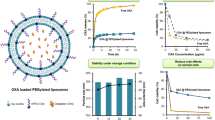Summary
Numerous studies have demonstrated that liposomal encapsulation decreases the life-threatening chronic and acute toxicities of doxorubicin in the face of unaltered or improved antitumor activity. Minimal attention has been paid to the encapsulation effect on the lesser toxicities of the drug, specifically the vesicant properties. In this report we assess the effect of the encapsulation of doxorubicin in an egg-yolk phosphatidylcholine (EPC) cholesterol liposome on the drug's topical toxicity. In addition, to ensure acceptable activity and reduction in toxicity comparable with those of previously assessed formulations, the cardiac and acute toxicities and antitumor activity of the liposomal doxorubicin complex were also investigated. Antitumor efficacy was assessed using the metastatic murine P815 mastocytoma model. Equivalent doses of free and encapsulated doxorubicin possessed the same antitumor activity in the prolongation of animal survival in 14-day survival studies conducted to assess the effect of liposomal encapsulation on the acute toxicity of this drug. The LD50 of liposomal doxorubicin was found to be 40 mg/kg, 53% higher than that of free doxorubicin (26 mg/kg). Histologic examination of cardiac sections taken from DBA/2J mice 7 days after a single i.v. injection of free or liposomal doxorubicin (25 mg/kg) revealed that the liposomal preparation was much less cardiotoxic. In animals receiving the free drug, edema, monocytic infiltration, and cell necrosis were evident. In contrast, those receiving the liposomal preparation demonstrated slight cellular edema but showed no evidence of cellular necrosis. To assess vesicant properties, DBA/2J mice were given a single s.c. injection (0.2 ml) of free or loposomal doxorubicin (2 mg/ml). Those receiving the free drug immediately developed erythema and edema at the injection site, which progressed to ulceration. Those receiving the liposomal complex developed slight erythema and edema but did not ulcerate at any time. All signs of irritation in this group had subsided 3 weeks postinjection. In summary, the liposomal complex used eliminated the vesicant properties of doxorubicin as well as significantly decreasing its cardiac and acute toxicities in the face of unaltered antitumor activity.
Similar content being viewed by others
References
Abra RM, Hunt CA (1981) Liposome distribution in vivo: III. Dose and vesicle size effects. Biochim Biophys Acta 666: 493–503
Averbuch SD, Gaudiano G, Koch TH, Bachan NR (1986) Doxorubicin induced skin necrosis in the swine model: protection with a novel radical dimer. J Clin Oncol 4: 99–94
Bosworth ME, Hunt CA (1982) Liposome deposition in vivo: II. Dose dependence. J Pharm Sci 7: 100–104
Calabresi P, Parks R (1975) Chemotherapy of neoplastic diseases. In: The pharmacological basis of therapeutics. MacMillan, New York, pp 1288–1290
Dorr R, Fritz W (1982) Drug data sheets, doxorubicin. In: Cancer chemotherapy handbook. Elsevier Science, New York, pp 388–401
Forssen EA, Tokes Z (1983) Improved therapeutic benefits of doxorubicin by entrapment in anionic liposomes. Cancer Res 43: 546–550
Forssen EA, Tokes ZA (1983) Attenuation of dermal toxicity of doxorubicin by liposome encapsulation. Cancer Treat Rep 67: 481–484
Gabizon A, Dagan D, Goren D, Barenholz Y, Fuks Z (1982) Liposomes as in vivo carriers of adriamycin: reduced cardiac uptake and preserved antitumor activity in mice. Cancer Res 42: 4734–4739
Gabizon A, Goren D, Fuks Z, Barenholz A, Dagan A, Meshorer A (1983) Enhancement of adriamycin delivery to liver metastatic cells with increased tumouricidal effect using liposome as drug carriers. Cancer Res 43: 4730–4735
Hope MJ, Bally MB, Webb G, Cullis PR (1985) Production of large unilamellar vesicle by rapid extrusion procedure. Characterization of size, trapped volume and ability to maintain a membrane potential. Biochim Biophys Acta 812: 55–65
Juliano RL, Layton D (1980) Liposomes as a drug delivery system. In: Drug delivery systems: characteristics and biomedical application. Oxford University Press, London, pp 189–236
Knoben J, Anderson P (1983) Antineoplastic agents. In: Handbook of clinical drug data. Drug Intelligence Publications, Hamilton, p 347
Mayer LD, Bally MB, Cullis PR (1986a) Uptake of adriamycin into large unilamellar vesicles in response to a pH gradient. Biochim Biophys Acta 85: 123–126
Mayer LD, Bally MB, Hope MJ, Cullis PR (1986b) Techniques for encapsulating bioactive agents into liposomes. Chem Phys Lipids 40: 333–345
Mayer LD, Hope MJ, Cullis PR, Janoff AS (1986c) Solute distributions and trapping efficiencies observed in freeze thawed multilamellar vesicles. Biochem Biophys Acta 817: 193–196
Mayhew E, Rustum Y (1985) The use of liposomes as carriers of therapeutic agents. In: Molecular basis of cancer, part B. Macromolecular recognition, chemotherapy, and immunology Alan Liss, New York, pp 301–310
Minow RA, Benjamin RS, Gottlieb JA (1975) Adriamycin cardiomyopathy: an overview with determination of risk factors. Cancer Chemother Rep 6: 195–201
Olson F, Mayhew E, Maslow D, Rustums Y, Szoka F (1982) Characterization, toxicity and therapeutic efficacy of adriamycin encapsulated in liposomes. Eur J Cancer 18: 167–175
Rahman A, Kessler A, More N, Sikic B, Rowden G, Woolley P, Schein P (1980) Liposomal protection of adriamycin induced cardiotoxicity in mice. Cancer Res 40: 1532–1537
Rahman A, White G, More N, Schein P (1985) Pharmacological, toxicological and therapeutic evaluation on mice of doxorubicin entrapped in cardiolipin liposomes. Cancer Res 45: 796–803
Senior J, Gregordiadis G (1982) Is half-life of circulating liposomes determined by changes in their permeability. FEBS Lett 145: 109–114
Shinozara S, Araki Y, Oov T (1981) Tissue distribution and anti-tumour effect of liposome entrapped doxorubicin (adriamycin) in Erlich solid tumor bearing mice. Acta Med Okayama 35: 395–4052
Author information
Authors and Affiliations
Rights and permissions
About this article
Cite this article
Balazsovits, J.A.E., Mayer, L.D., Bally, M.B. et al. Analysis of the effect of liposome encapsulation on the vesicant properties, acute and cardiac toxicities, and antitumor efficacy of doxorubicin. Cancer Chemother. Pharmacol. 23, 81–86 (1989). https://doi.org/10.1007/BF00273522
Received:
Accepted:
Issue Date:
DOI: https://doi.org/10.1007/BF00273522




